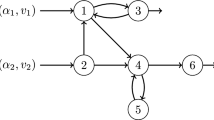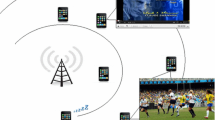Abstract
In this paper, flow models of networks without congestion control are considered. Users generate data transfers according to some Poisson processes and transmit corresponding packet at a fixed rate equal to their access rate until the entire document is received at the destination; some erasure codes are used to make the transmission robust to packet losses. We study the stability of the stochastic process representing the number of active flows in two particular cases: linear networks and upstream trees. For the case of linear networks, we notably use fluid limits and an interesting phenomenon of “time scale separation” occurs. Bounds on the stability region of linear networks are given. For the case of upstream trees, underlying monotonic properties are used. Finally, the asymptotic stability of those processes is analyzed when the access rate of the users decreases to 0. An appropriate scaling is introduced and used to prove that the stability region of those networks is asymptotically maximized.
Similar content being viewed by others
References
Billingsley, P.: Convergence of Probability Measures, 2nd edn. Wiley Series in Probability and Statistics. Wiley, New York (1999)
Bonald, T., Borst, S.C., Proutière, A.: How mobility impacts the flow-level performance of wireless data systems. In: Proceedings of INFOCOM, vol. 3, pp. 1872–1881 (2004)
Bonald, T., Massoulié, L., Proutière, A., Virtamo, J.: A queueing analysis of max-min fairness, proportional fairness, and balanced fairness. Queueing Syst.: Theory Appl. 53, 65–84 (2006)
Bonald, T., Feuillet, M., Proutière, A.: Is the “Law of the Jungle” sustainable for the Internet? In: Proceedings of INFOCOM, pp. 28–36, April (2009)
Borst, S., Jonckheere, M., Leskelä, L.: Stability of parallel queueing systems with coupled service rates. Discret. Event Dyn. Syst. 18(4), 447–472 (2008)
Dai, J.G.: On positive Harris recurrence of multiclass queueing networks: a unified approach via fluid limit models. Ann. Appl. Probab. 5, 49–77 (1995)
Dumas, V., Guillemin, F., Robert, P.: A Markovian analysis of additive-increase multiplicative-decrease (AIMD) algorithms. Adv. Appl. Probab. 34(1), 85–111 (2002)
Ethier, S.N., Kurtz, T.G.: Markov Processes: Characterization and Convergence. Wiley, New York (1986)
Floyd, S.: Highspeed TCP for large congestion windows. RFC 896 (2003)
Ganesh, A., Lilienthal, S., Manjunath, D., Proutière, A., Simatos, F.: Load balancing via random local search in closed and open systems. In: SIGMETRICS, pp. 287–298 (2010)
Gronwall, T.H.: Note on the derivatives with respect to a parameter of the solutions of a system of differential equations. Ann. Math, 2nd Ser. 20(4), 292–296 (1919)
Hunt, P.J., Kurtz, T.G.: Large loss networks. Stoch. Process. Appl. 53(2), 363–378 (1994)
Jin, Cheng, Wei, D.X., Low, S.H.: FAST TCP: motivation, architecture, algorithms, performance. In: INFOCOM 2004, vol. 4, pp. 2490–2501 (2004)
Kurtz, T.G.: Averaging for martingale problems and stochastic approximation. In: Applied Stochastic Analysis, US-French Workshop. Lecture Notes in Control and Information Sciences, vol. 177, pp. 186–209. Springer, Berlin (1992)
Massey, W.A.: Stochastic orderings for Markov processes on partially ordered spaces. Math. Oper. Res. 12(2), 350–367 (1987)
Massoulié, L., Roberts, J.W.: Bandwidth sharing and admission control for elastic traffic. Telecommun. Syst. 15, 185–201 (2000)
Meyn, S.: Transience of multiclass queueing networks via fluid limit models. Ann. Appl. Probab. 5, 946–957 (1995)
Mitzenmacher, M.: Digital fountains: a survey and look forward. In: Information Theory Workshop, 2004, pp. 271–276. IEEE, New York (2004)
Nagle, J.: Congestion Control in IP/TCP Internetworks. RFC 896, January (1984)
Raghavan, B., Snoeren, A.C.: Decongestion control. In: Proceedings of the 5th ACM Workshop on Hot Topics in Networks, November (2005)
Robert, P.: Stochastic Networks and Queues. Stochastic Modeling and Applied Probability Series. Springer, New York (2003). xvii+398 pp.
Rogers, L.C.G., Williams, D.: Diffusions, Markov Processes & Martingales, vol. 1: Foundations. Cambridge University Press, Cambridge (2000) (1979)
Rogers, L.C.G., Williams, D.: Diffusions, Markov Processes & Martingales, vol. 2: Itô Calculus. Cambridge University Press, Cambridge (2000) (1987)
Simatos, F., Tibi, D.: Spatial homogenization in a stochastic network with mobility. Ann. Appl. Probab. 20(1), 321–355 (2010)
Xu, L., Harfoush, K., Rhee, I.: Binary increase congestion control (BIC) for fast long-distance networks. In: INFOCOM 2004, vol. 4, pp. 2514–2524 (2004)
Author information
Authors and Affiliations
Corresponding author
Rights and permissions
About this article
Cite this article
Feuillet, M. On the flow-level stability of data networks without congestion control: the case of linear networks and upstream trees. Queueing Syst 70, 105–143 (2012). https://doi.org/10.1007/s11134-011-9265-7
Received:
Revised:
Published:
Issue Date:
DOI: https://doi.org/10.1007/s11134-011-9265-7




